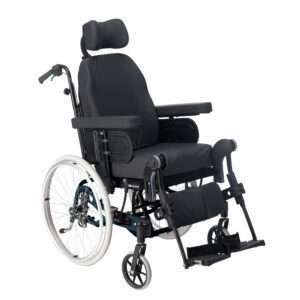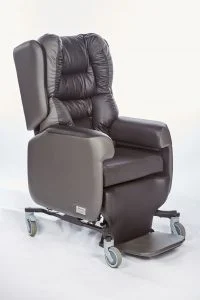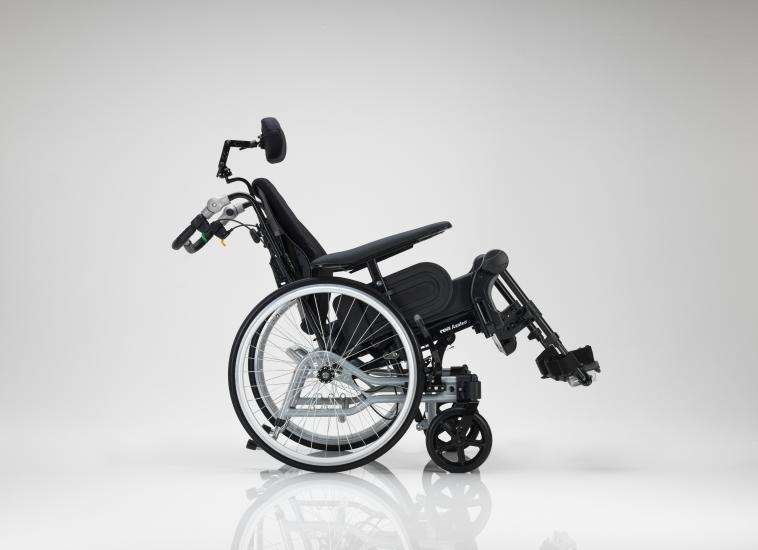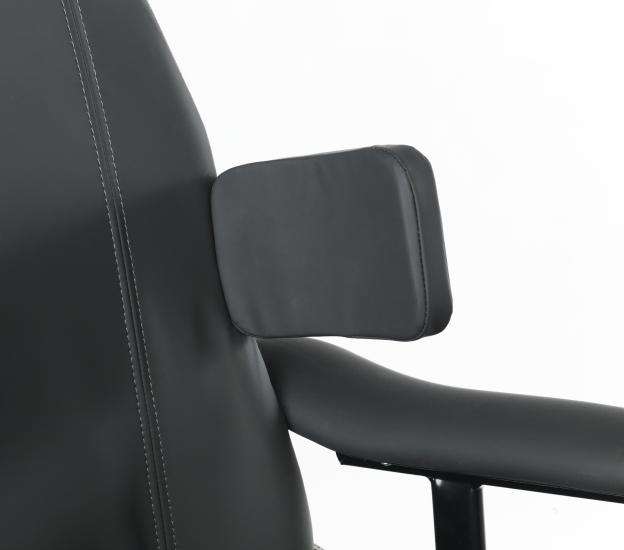For carers attending to care home residents or family members who need additional support, a question that often gets asked is, what type of chair should be used?
Two types of seating often used in patient care facilities are care chairs and tilt-in-space (TIS) wheelchairs.
Jump straight to…
What is the Difference between a Care Chair and a Tilt in Space Wheelchair?
The main differences between care chairs and tilt-in-space wheelchairs lies in their design, purpose and the types of users they are intended to serve. Let’s take a closer look at the key differences between the two types of chair, to help you decide which is best for your needs.
Primary Use
Care chairs are primarily used in patient care facilities for people with limited mobility, who need support in carrying out basic activities such as eating, sleeping, dressing and toileting. Conditions of these patients vary greatly and can be due to an inherited neurological disorder (e.g. MND) or paralysis from life-changing injuries.
Rather than being mobile like a wheelchair, the care chair is intended to be used a static chair that remains within the patient’s room for round the-clock postural support and transfers between the chair and the bed/toilet.
For patients who are unable to adjust their posture, head-to-toe comfort and pressure relief are essential features of these chairs. Round-the-clock postural support is essential these users, such as those with advanced neurological disorders, so care chairs are often used in care homes or palliative care facilities like hospices.

Lento Care Chair
Tilt-in-space wheelchairs are ideal for people with more complex mobility or postural needs who are not in a managed care facility, and need the mobility to get around the home and local community.
An example of a TIS wheelchair is the Rea Azalea, that has large range of postural accessories to adapt the chair to the specific postural needs of the individual. Adjustable headrests with all-round head support can be added for individuals with poor head control.

Rea Azalea tilt-in-space wheelchair
Design and Functionality
A care chair is designed for comfort and postural support for longer periods of time, typically used in care homes or hospitals for people with severely limited mobility.
In terms of design function, care chairs are highly padded and usually upholstered in a washable fabric that wipes down easily. As they are used for patients with weak muscle tone and poor skin integrity, they are fully cushioned from head to toe. Care chairs like the Lento care chair feature padded legrests and footplates, and different backrests like the cocoon that be interchanged to give a high level of sideways cushioning and support.

Lento care chair with cocoon backrest
Tilt-in-space is standard with most care chairs, which rocks the patient back in the chair to distribute their weight over a wider surface area. Care chairs have more positioning capabilities than TIS wheelchairs, and have a choice or manual or electric action, whereas TIS wheelchairs are just manually operated.
Regulated motion can be added to allow the degree of tilt-in-space to be adjusted at set time increments, for very high-risk users.
Tilt in space (TIS) wheelchairs incorporate the tilt-in-space function so that the patient can be tilted and repositioned as required. The Rea Azalea chair has 25 degrees of seat tilt and 30 degrees of backrest recline. This is ideal for users who need to shift their weight or have difficulty with muscle tone or postural control.

Rea Azalea in tilt position
As the name would suggest, they are designed to be more mobile and transport the patient between locations, for example in a wheelchair-accessible vehicle (WAV). Most TIS wheelchairs are crash-tested for this purpose, which is denoted with the ‘hook’ symbol on the frame.

Tilt in space wheelchairs tend to be more customisable than care chairs, with a longer list of add-ones and accessories to customise them to the individual’s postural needs. Examples of these accessories are legrest extensions, tension adjustable backrests, and a range of different armrests and head supports.

Mobility
Care chairs are static chairs, designed for enhanced comfort and pressure relief rather than mobility. This makes them ideal for people who cannot reposition themselves unaided, and they can even be used for patients to sleep in. They have braked castors for easy movement around the patient’s room and care facility, with push handles for the attendant to operate, but they are not designed for independent mobility.
Tilt-in-Space Wheelchairs are designed for users who need to move between different locations, and can be attendant-propelled, powered by a joystick or manually propelled by the patient using the handrims (self-propelled). Most have push handles at the back so they can be easily moved around by staff. Being a lot lighter than care chairs, they are designed to be used on the move and outdoors on hard surfaces. A powerpack can be added to the rear wheels to assist the carer when pushing the chair up slopes.
Target Users
Care Chairs are suitable for people with very limited mobility or those who need to remain seated for extended periods with minimal movement, such as very weak/frail patients or those with brain or spinal cord injuries.
Tilt-in-Space Wheelchairs are ideal for individuals with conditions affecting muscle tone, such as cerebral palsy or muscular dystrophy, who need pressure relief and postural support while being mobile. They can be also used a temporary measure for people rehabilitating from surgery or injuries that affect their mobility.
Similarities Between Care Chairs and Tilt in Space Wheelchairs
Having covered the differences between the two chairs, there are some features that are common to both types of chairs, which it is helpful to be aware of.
Tilt-in-space
Both types of chairs have tilt-in-space, which is manually operated on a TIS wheelchair and can be either manual or electric on a care chair.
Postural aids and pressure relief
Postural aids such as lap belts and seat harnesses can be added to both types of chairs. Both chairs can be used to provide enhanced pressure relief, with various grades of cushions from foam to alternating air, either built into the seat and contact surfaces of the care chair, or attached as a separate cushion on the wheelchair.
Adjustability
Both types of chairs are usually height, depth, footplate, and back angle adjustable. Whereas care chairs such as the Lento have fully adjustable seat dimensions, TIS wheelchairs are not usually width adjustable.
Suitable for transfers
The tilt-in-space function makes both types of chairs ideal for sling transfers using either mobile or fixed tracking hoists.

Range of Users
Both types of chairs are available in paediatric to bariatric sizes, for children up to adults and plus-size individuals.
The Little Lento is a scaled-down version of the Lento care chair with all the same features and accessory options for children and small adults.

Little Lento care chair
Summary
The care chair is focused on long-term seating, comfort, and postural support for immobile users, and is best for users in care facilities who need high levels of personal care such as hoisting.
The tilt-in-space wheelchair is a mobility chair that offers advanced pressure relief and postural management, for users who need help with repositioning but still require a wheelchair for movement. It is better suited for wheelchair users who are seated for longer periods of time but still need to be independently mobile.
Speak to our team today















